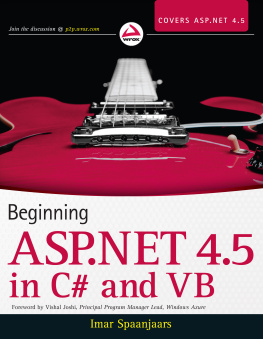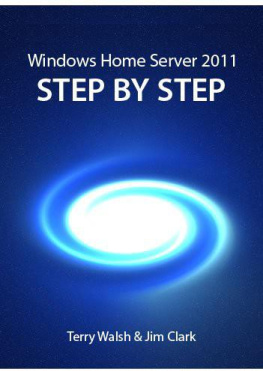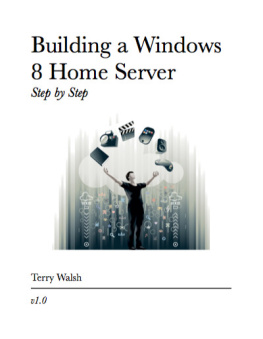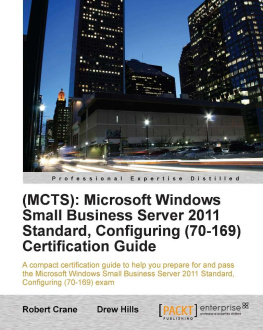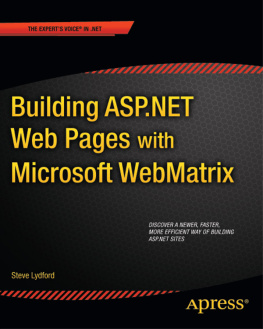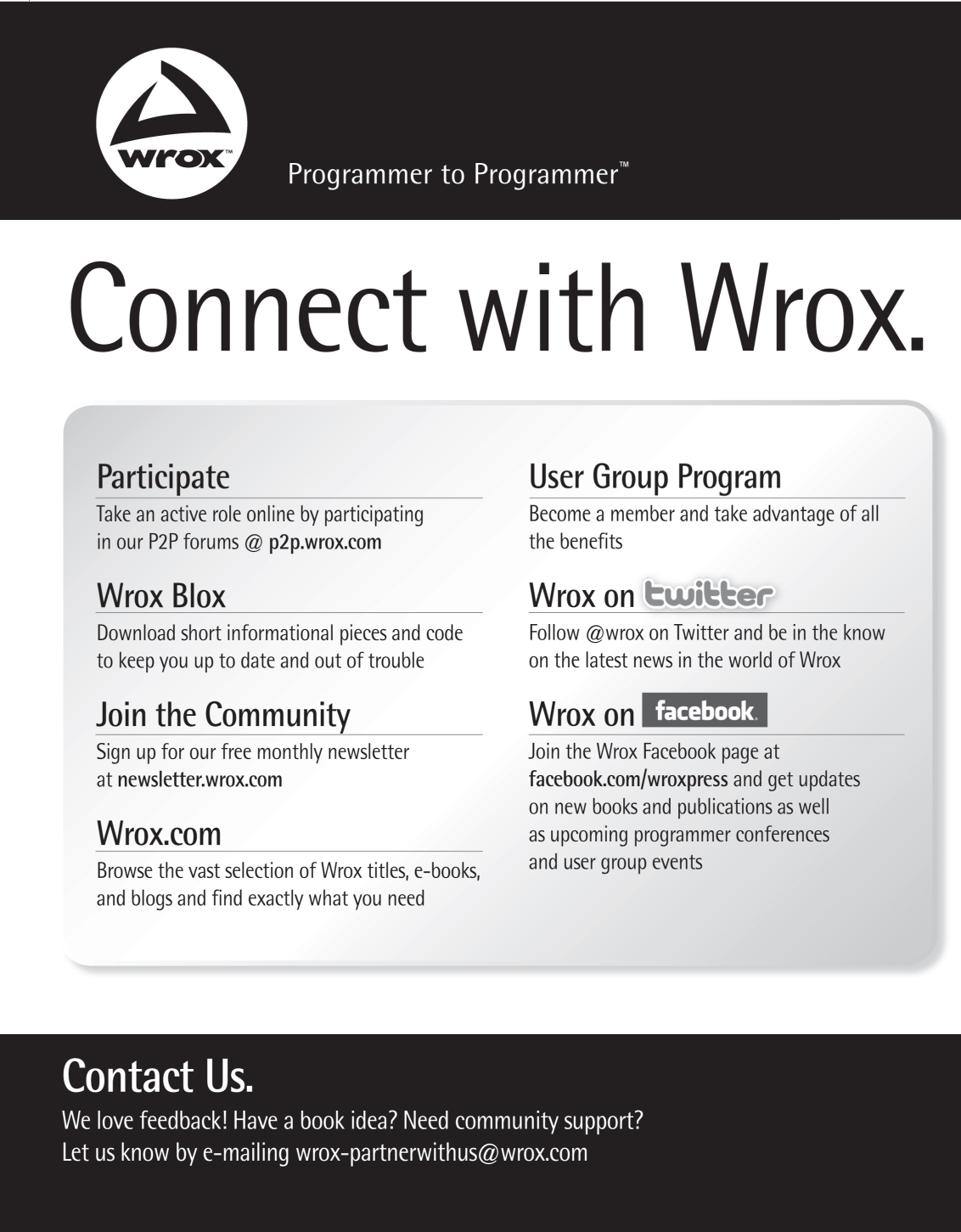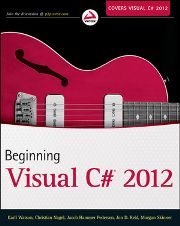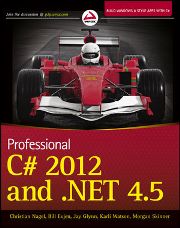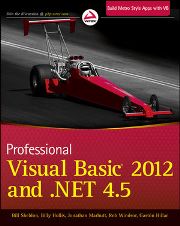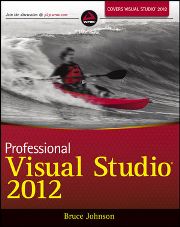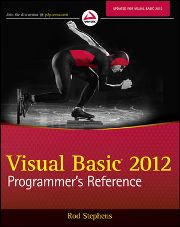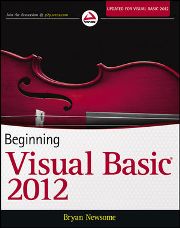Visit www.safaribooksonline.com/wrox to get started
Related Wrox Books
Beginning Microsoft Visual C# 2012, by Karli Watson, Jacob Vibe Hammer, Jon Reid, Morgan Skinner, Daniel Kemper, Christian Nagel
Learn more
ISBN: 978-1-118-31441-8
Using this book, you will first cover the fundamentals such as variables, flow control, and object-oriented programming and gradually build your skills for web and Windows programming, Windows forms, and data access. Step-by-step directions walk you through processes and invite you to Try it Out, at every stage. By the end, you'll be able to write useful programming code following the steps you've learned in this thorough, practical book. If you've always wanted to master Visual C# programming, this book is the perfect one-stop resource.
Professional C# 2012 and .NET 4.5, by Christian Nagel, Bill Evjen, Jay Glynn, Karli Watson and Morgan Skinner
Learn more
ISBN: 978-1-118-31442-5
After a quick refresher on C# basics, the team of expert authors dives in to deliver unparalleled coverage on recent language and framework additions, as well as new test driven development and concurrent programming features. Ultimately, this book provides you with everything you need to know about C# 2012 and .NET 4.5 so that you can maximize the potential of these dynamic technologies
Professional Visual Basic 2012 and .NET 4.5, by Bill Sheldon, Billy Hollis, Rob Windsor, David McCarter, Gastn Hillar and Joacim Andersson
Learn more
ISBN: 978-1-118-31445-6
Written by an author team of veteran programmers and developers, this book gets you quickly up to speed on what you can expect from Visual Studio 2012. Packed with helpful examples, this comprehensive guide examines the features of Visual Studio 2012, and walks you through every facet of the Integrated Development Environment (IDE), from common tasks and functions to its powerful tools.
Professional Visual Studio 2012, by Bruce Johnson
Learn more
ISBN: 978-1-118-33770-7
This book is what you need to get up and running quickly on Visual Studio 2012. Written by a Microsoft Visual C# MVP, it guides you through the integrated development environment (IDE), showing you how to maximize each of the tools and features.
Visual Basic 2012 Programmer's Reference, by Rod Stephens
Learn more
ISBN: 978-1-118-31407-4
Visual Basic 2012 is packed with powerful features and this book will help you master them all. You'll gain a solid understanding of essential Visual Basic topics and begin applying the information to perform a host of important development tasks. The tutorials inside are filled with code examples and the best methods for using them to write your own programs.
Beginning Visual Basic 2012, by Bryan Newsome
Learn more
ISBN: 978-1-118-31181-3
This book not only shows you how to write Windows applications, web applications with ASP.NET, and Windows mobile and embedded CE apps with Visual Basic 2012, but you'll also get a thorough grounding in the basic nuts-and-bolts of writing good code. You'll be exposed to the very latest VB tools and techniques with coverage of both the Visual Studio 2012 and .NET 4.5 releases. Launch your Visual Basic programming career the right way with this practical, thorough guide.

Chapter 1
Getting Started with ASP.NET 4.5
What you will learn in this chapter:
- How to acquire and install Visual Studio Express 2012 for Web and Visual Studio 2012
- How to create your first website with Visual Studio Express 2012
- How an ASP.NET page is processed by the server and sent to the browser
- How you can use and customize the development environment
Ever since the first release of the .NET Framework 1.0 in early 2002, Microsoft has put a lot of effort and development time into ASP.NET, the part of the .NET Framework that enables you to build rich web applications. This first release meant a radical change from the older Microsoft technology to build websites called ActiveServerPages (ASP), now often referred to as classicASP. The introduction of ASP.NET 1.0 and the associated Visual Studio .NET gave developers the following benefits over classic ASP:
- A clean separation between presentation and code. With classic ASP, your programming logic was often scattered throughout the HTML of the page, making it hard to make changes to the page later.
- A development model that was much closer to the way desktop applications are programmed. This made it easier for the many Visual Basic desktop programmers to make the switch to web applications.
- A feature-rich development tool (called Visual Studio .NET) that enabled developers to create and code their web applications visually.
- A choice between a number of object-oriented programming (OOP) languages, of which Visual Basic .NET and C# (pronounced as C-Sharp) are now the most popular.
- Access to the entire .NET Framework, which for the first time meant that web developers had a unified and easy way to access many advanced features to work with databases, files, e-mail, networking tools, and much more.
Despite the many advantages of ASP.NET over the older model, using ASP.NET also meant an increase in complexity and the knowledge needed to build applications with it, making it harder for many new programmers to get started with ASP.NET.
After the initial release in 2002, Microsoft released another version of the .NET Framework (called .NET 1.1) and the development IDE (called Visual Studio .NET 2003). Many people saw this as a service pack for the initial release, although it also brought a lot of new enhancements in both the framework and the development tools.
In November 2005, Visual Studio 2005 and ASP.NET 2.0 were released. To the pleasant surprise of many developers around the world, Microsoft had again been able to drastically improve and expand the product, adding many features and tools that helped reduce the complexity that was introduced with ASP.NET 1.0. New wizards and smart controls made it possible to reduce the code required to build an application, decreasing the learning curve for new developers and increasing their productivity.

